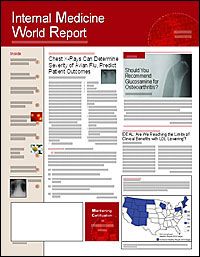Publication
Article
Internal Medicine World Report
New Clinical Guidelines Detail Sinusitis Diagnosis and Management
Author(s):
The American Academy of Allergy, Asthma & Immunology has issued revised practice guidelines for the diagnosis and management of sinusitis, including an updated definition of sinusitis and new recommendations for the use of antibiotics, corticosteroids, decongestants, and other agents for its treatment. They replace the 1998 guidelines and incorporate a clinical management algorithm with narrative annotations designed to assist clinical decision making.
The new guidelines define sinusitis as inflammation of >=1 of the paranasal sinuses, most often as a result of infection. The updated classification of sinusitis is based on the duration of symptoms, the specific sinus involved, or both, as noted in the Table.
A noninfectious form of chronic sinusitis, termed chronic hyperplastic eosinophilic sinusitis, is also addressed in the guidelines, but the optimal management approach remains controversial. The disorder is characterized by a preponderance of eosinophils and mixed mononuclear cells, with a relative paucity of neutrophils. It is often associated with nasal polyps, asthma, and aspirin sensitivity.
"Certainly the biggest current controversy in this area is the pathogenesis and treatment of chronic hyperplastic eosinophilic sinusitis," said lead author Raymond G. Slavin, MD, of the St. Louis University Health Science Center. "This condition does not respond to either antibiotics or surgery. There are some who feel that the majority of cases are due to commonly encountered fungi such as Alternaria species, and that the treatment of choice is antifungal agents administered into the nose."
The guidelines state that acute bacterial sinusitis should be suspected in patients with upper respiratory tract infection that persists beyond 10 to 14 days. A history of persistent purulent rhinorrhea, postnasal drainage, and facial pain increase the likelihood of bacterial disease.
Imaging techniques, in?cluding A-mode ultrasonography, standard radiography, computed tomography (CT), and magnetic resonance imaging, are recommended when confirmatory evidence is needed in patients with vague symptoms, equivocal physical findings, or persistent disease despite optimal medical therapy.
The guidelines also provide recommendations for the use of laboratory evaluations including nasal cytology, nasal-sinus biopsy, and tests for immunodeficiency, cystic fibrosis, and ciliary dysfunction. The guidelines include a review of the evidence in support of the association between sinusitis and predisposing factors, including viral upper respiratory tract infection and allergic and nonallergic rhinitis, and discuss the clinical implications of the similarities between sinusitis and otitis media, including histologic features, pathogenesis, and risk factors.
The guidelines advocate antibiotics as the primary form of medical treatment for bacterial sinusitis. The bacteria most commonly observed in patients with acute sinusitis, recurrent acute sinusitis, and acute exacerbations of chronic sinusitis include Strep?to?coc?cus pneumoniae, Haemo??philus influenzae, and Moraxella catarrhalis.
Amoxicillin (eg, Tri?mox, Amoxil) is ?des?cribed as a reasonable initial antibiotic choice in adults and children with un?complicated disease. Other recommended treatment options include second- and third-generation cepha?losporins, select quinolones, and the ketolide telithromycin (Ketek).
The guidelines indicate that antihistamines may have a role in the treatment of chronic sinusitis if allergic rhinitis is the underlying risk factor. Adjunctive therapies including decongestants, systemic corticosteroids, mucolytics, and expectorants are considered beneficial in some patients, but pro?spective studies are lacking.
"In addition to details of the advances in our understanding of sinusitis, a major difference between the previous and ?current version of the guidelines is the addition of indications for referral," Dr Slavin said. These indications include:
? The condition or its treatment interferes with a patient's performance or ?significantly affects his or her ?quality of life
? A patient who has complications of sinusitis, such as asthma, bronchiectasis, nasal polyps, or bronchitis
? When an allergic or immunologic basis for sinusitis is being considered
? Sinusitis that is chronic, recurrent, or persistent despite treatment by the primary care physician
? Complex pharmacology is needed to treat recalcitrant infections.
The guidelines note that medically resistant sinusitis may respond favorably to appropriate nasal sinus surgery, and that functional endoscopic sinus surgery may provide significant im?provement in patients with localized persistent disease within the osteomeatal complex. The complete guidelines are published in the Journal of Allergy and Clinical Immunology (2005; 116:?S13-S47) and are available online at www.jacionline.org.






